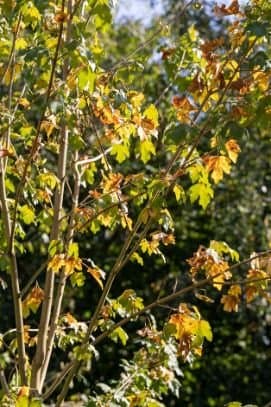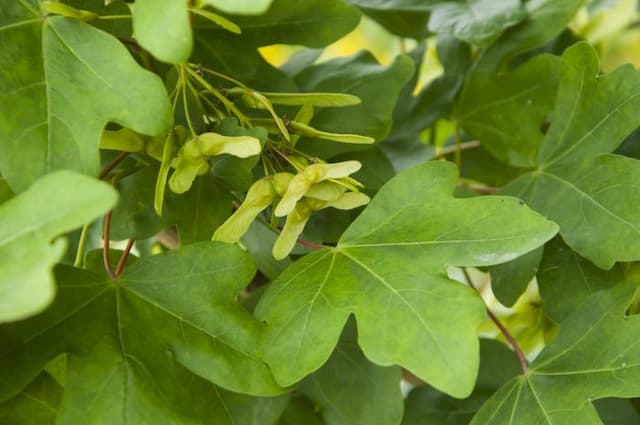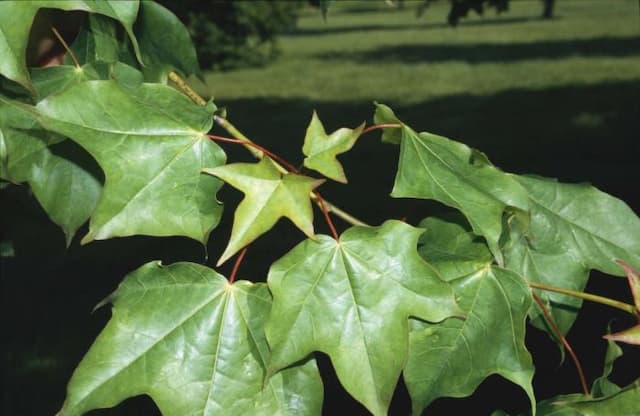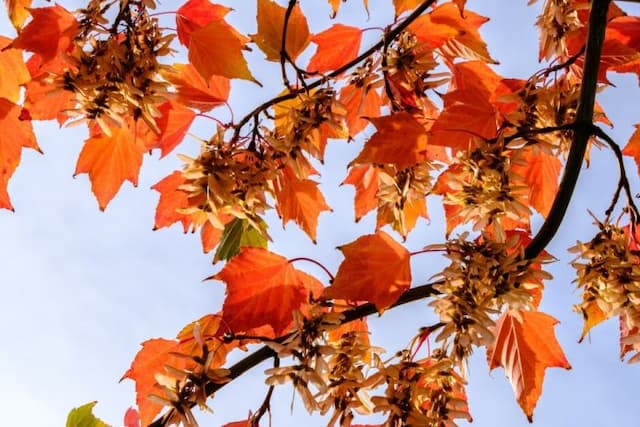Japanese maple Acer palmatum 'Bloodgood' (A)

ABOUT
Acer palmatum 'Bloodgood', commonly known as the Bloodgood Japanese Maple, is recognized for its captivating beauty throughout the seasons. Its leaves are one of its most distinctive features, having a palmate shape with multiple lobes, resembling an open hand. The leaf color is a deep, rich purple-red that holds throughout the summer season, providing an enduring splash of color in the landscape. The intensity of the foliage color can vary depending on the amount of sunlight the plant receives; more sun generally leads to a deeper color. During autumn, the leaves of the Bloodgood Japanese Maple undergo a dramatic transformation, showcasing a vibrant array of red shades that add a fiery accent to the cooling temperatures. Aside from the foliage, the beauty of this plant is also evident in its bark, which has a smooth texture and can have a subtle reddish tinge that adds to the overall aesthetic of the tree. The branching structure of the Bloodgood Japanese Maple is also noteworthy, with an elegant, rounded form that provides visual interest year-round. In winter, when the leaves have fallen, the silhouette of its delicate branches creates a stark and striking pattern against the sky. Flowers and fruit of the Bloodgood Japanese Maple are typically less prominent in comparison to its foliage but still contribute to its ornate character. During spring, small reddish-purple flowers can appear, followed by samaras, which are winged seed pods that dangle from branches, twirling to the ground when they ripen and are dispersed by wind. Overall, the Bloodgood Japanese Maple exudes a stately yet graceful presence in the landscape, characterized by the vivid and changing colors of its foliage, the smooth-textured bark, and its balanced branching structure. It provides gardeners with a stunning focal point throughout each season without the need for excessive care.
About this plant
 Names
NamesFamily
Sapindaceae.
Synonyms
Japanese Maple, Bloodgood Japanese Maple, Bloodgood Maple.
Common names
Acer palmatum 'Bloodgood'
 Toxicity
ToxicityTo humans
The Japanese Maple is not considered toxic to humans. Ingesting parts of this plant is not expected to cause poisoning or serious harm. However, as with any non-food plant, individual reactions can vary, and it is still advisable to prevent children from eating any part of ornamental plants.
To pets
The Japanese Maple is generally considered non-toxic to pets as well. Dogs, cats, and other domesticated animals can usually ingest leaves or twigs without serious risk of poisoning. However, it's still recommended to prevent pets from habitual consumption of plant material, and observe for any signs of distress, as individual sensitivities may vary.
 Characteristics
CharacteristicsLife cycle
Perennials
Foliage type
Deciduous
Color of leaves
Dark red
Height
15-20 feet (4.5-6 meters)
Spread
15 feet (4.5 meters)
Plant type
Tree
Hardiness zones
5-8
Native area
Japan
Benefits
 General Benefits
General Benefits- Ornamental Beauty: A adds visual interest to gardens with its deep purple-red leaves that change to crimson red in the fall.
- Shade Provider: Its canopy can offer shade in gardens and yards, creating a cooler microclimate during hot months.
- Erosion Control: The root system helps to stabilize soil and prevent erosion on slopes or banks.
- Habitat for Wildlife: A provides shelter and potential food sources for birds and other wildlife.
- Seasonal Interest: Offers year-round interest with foliage color changes and attractive winter silhouette.
- Compact Size: Ideal for smaller gardens due to its relatively small size compared to other tree species.
- Privacy Screen: Can be used to create a natural privacy screen when planted in groups or as a hedge.
- Easy to Prune: Responds well to pruning, allowing gardeners to shape the tree to their preference.
- Drought Tolerance: Once established, it is relatively drought tolerant, requiring minimal water during dry periods.
 Medical Properties
Medical PropertiesThis plant is not used for medical purposes.
 Air-purifying Qualities
Air-purifying QualitiesThis plant is not specifically known for air purifying qualities.
 Other Uses
Other Uses- Acer palmatum 'Bloodgood', commonly known as Japanese Maple, can be used in bonsai creation. This form of art uses careful pruning and training to shape the tree into a miniature representation of a full-grown tree.
- The wood of Japanese Maple is sometimes used in the making of small woodcraft items. Its fine grain and interesting color can add character to items like jewelry boxes or picture frames.
- Japanese Maple trees can be used in traditional Japanese garden design, not only for their aesthetic value but also as a symbol of change and elegance.
- The leaves of Japanese Maple may be pressed and dried to create natural decorative elements for craft projects, like in scrapbooking or card making.
- Photographers and artists often use Japanese Maple trees as subjects for their work because of their striking appearance, especially during autumn.
- Japanese Maples can be planted to provide shade in small garden spaces where larger trees would not be appropriate.
- The striking foliage of Japanese Maple is sometimes used in floral arrangements to provide an interesting contrast to flowers.
- Dried leaves from the Japanese Maple can be used in potpourri mixes, providing an artistic touch to the blend with their distinctive shape and color.
- Japanese Maple trees can serve as a natural privacy screen in gardens, given their dense growth habit when allowed to mature.
- Culinary enthusiasts sometimes use Japanese Maple leaves as a natural food plating element to add a unique visual appeal to dishes, especially in high-end or artistic culinary presentations.
Interesting Facts
 Feng Shui
Feng ShuiThe Japanese Maple is not used in Feng Shui practice.
 Zodiac Sign Compitability
Zodiac Sign CompitabilityThe Japanese Maple is not used in astrology practice.
 Plant Symbolism
Plant Symbolism- Peace and Tranquility: Japanese Maples, in general, are often found in traditionally structured Japanese gardens, which are designed to promote a sense of peace and tranquility through their carefully planned aesthetics and harmonious elements.
- Beauty and Grace: The 'Bloodgood' cultivar of Japanese Maple, with its striking red foliage, is commonly associated with beauty and grace, as it provides a visually captivating display that changes with the seasons.
- Endurance and Strength: Japanese Maples have the ability to withstand cold temperatures and the changing seasons, symbolizing endurance and strength to persevere through challenging conditions.
- Balance and Harmony: The balanced growth habit and delicate leaves of the 'Bloodgood' Japanese Maple are often viewed as a symbol of balance and harmony in life, reflecting the importance of both in Japanese culture.
 Water
WaterThe Bloodgood Japanese Maple requires even moisture and should be watered deeply once a week, ensuring the soil is moist but not waterlogged. During dry spells or in particularly hot climates, it may be necessary to increase watering frequency to twice a week. Generally, use approximately 10 gallons per watering session for a young tree, adjusting the amount as the tree matures and depending on the weather conditions. Avoid overhead watering to prevent leaf scorch and disease; instead, water directly at the base of the plant. Always check the soil moisture before watering; the tree will require less frequent watering during the cooler months.
 Light
LightBloodgood Japanese Maple thrives in partial to full sunlight, preferring a spot that offers morning sun and afternoon shade to protect its foliage from the harsh afternoon rays. It can tolerate full sun in cooler climates, but in warmer regions, the soft afternoon shade is vital to prevent leaf burn. Proper lighting is crucial for the vivid coloration of its leaves.
 Temperature
TemperatureBloodgood Japanese Maple is hardy and can withstand a range of temperatures, but it thrives in areas where the average temperature remains within 60 to 70 degrees Fahrenheit. It can survive temperatures as low as -20 degrees Fahrenheit in winter but should be protected from harsh winds. During summer, ensure it is not exposed to prolonged periods over 90 degrees Fahrenheit, which can stress the plant and cause leaf scorch.
 Pruning
PruningPrune the Bloodgood Japanese Maple to maintain its shape and health during its dormant period in late winter or early spring before new growth begins. Remove any dead, damaged, or crossing branches to improve air circulation and light penetration. Pruning is also an opportunity to accentuate the tree's natural form; do so sparingly to maintain a tree-like shape, as excessive pruning can lead to poor growth and structure.
 Cleaning
CleaningAs needed
 Soil
SoilBloodgood Japanese Maple thrives in well-draining, consistently moist soil with a pH of 5.5 to 6.5. A soil mix with organic matter such as peat moss or leaf mold will support its growth.
 Repotting
RepottingRepot your Bloodgood Japanese Maple approximately every 2 to 3 years to refresh the soil and encourage healthy growth.
 Humidity & Misting
Humidity & MistingBloodgood Japanese Maple prefers average humidity levels but is adaptable and does not require specific humidity adjustments.
 Suitable locations
Suitable locationsIndoor
Provide bright, indirect light and keep away from dry heat sources.
Outdoor
Choose a sheltered location with dappled sunlight and protect from harsh winds.
Hardiness zone
5-8 USDA
 Life cycle
Life cycleThe Bloodgood Japanese Maple (Acer palmatum 'Bloodgood') life cycle begins with seed germination, typically in the spring after stratification, which involves exposure to cold temperatures to break dormancy. The young sapling emerges, establishing a root system and growing vertically, developing its characteristic palmate leaves that are initially green and change to deep burgundy-red as the tree matures. Over several years, the tree reaches its juvenile stage, characterized by rapid growth and the beginning of branching, eventually taking on a more refined shape with a beautiful canopy. As the tree reaches maturity, which can take several years, it begins flowering and producing winged samaras, or helicopter seeds, which disperse in the wind to propagate new trees. The mature Bloodgood Japanese Maple experiences annual growth and seasonal changes, with leaves turning brilliant red in the fall before abscission. This ornamental tree has a lifespan that can extend up to 80-100 years with proper care and supportive growing conditions.
 Propogation
PropogationPropogation time
Early spring
The Japanese Maple 'Bloodgood' is most commonly propagated through softwood cuttings. This technique is typically done in the early summer when the new growth is still flexible. To propagate, a 4 to 6-inch cutting from a healthy branch is taken, making sure that there are at least two or three sets of leaves on the cutting. The leaves on the lower half are removed, and the cut end may be treated with rooting hormone to enhance root development. The cutting should then be placed in a well-draining potting mix, ensuring that the soil remains moist but not soggy. A plastic cover or bag can be used to maintain humidity levels around the cutting, which is helpful for root growth. With proper care and environmental conditions, roots will begin to form typically within a few weeks to a couple of months.







![Freeman maple [Autumn Blaze]](/_next/image?url=https%3A%2F%2Fplants-admin.emdemapps.com%2Fimages%2Fplants%2F%2Fimages%2F604b575b84d87.png&w=640&q=75)

